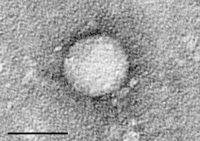
Photo from wikipedia
Background: For chronic hepatitis C (CHC) patients completing pegylated interferon (PegIFN)-α/ribavirin therapy, long-term liver histological changes remain largely unexplored. Methods: This observational cohort study included 85 CHC patients completing PegIFN-α/ribavirin… Click to show full abstract
Background: For chronic hepatitis C (CHC) patients completing pegylated interferon (PegIFN)-α/ribavirin therapy, long-term liver histological changes remain largely unexplored. Methods: This observational cohort study included 85 CHC patients completing PegIFN-α/ribavirin therapy with liver biopsies performed at baseline and the end of surveillance (EOS). Median years between paired biopsies were 6.75 (interquartile range: 5.63–7.54). Results: In patients with baseline METAVIR fibrosis stages (F) <4 (able to undergo fibrosis progression; n = 77), cases achieving sustained virological response (SVR) (n = 52) had a significantly lower rate of fibrosis progression than non-SVR cases (n = 25) (3.8% versus 24.0%, p = 0.012). Among the entire cohort (n = 85), the rate of activity response [METAVIR activity grades (A) decreasing or maintaining at A0] in SVR cases (n = 59) was significantly higher than that in non-SVR cases (n = 26) (94.9% versus 65.4%, p = 0.001). For SVR cases among the entire cohort, independent predictors of fibrosis clearance included baseline F <2 [odds ratio (OR) = 7.877, p = 0.042] and aspartate transaminase (AST) levels declining by >70% at EOS compared with baseline (OR = 9.013, p = 0.038). For non-SVR cases among the entire cohort, baseline AST levels >80 U/l and glucose levels ⩽ 105 mg/dl independently predicted significant fibrosis (F2/F3/F4) at EOS (OR = 12.558, p = 0.049) and activity response (OR = 17.741, p = 0.047), respectively. Conclusions: Among CHC patients completing PegIFN-α/ribavirin therapy, SVR lowers the risk of liver histological progression but does not guarantee fibrosis clearance. For SVR cases, those with baseline F ⩾ 2 or without significantly declined follow-up AST levels should be specifically monitored. As for non-SVR cases, those with a higher baseline AST or glucose level should preferentially receive retreatment.
Journal Title: Therapeutic Advances in Chronic Disease
Year Published: 2022
Link to full text (if available)
Share on Social Media: Sign Up to like & get
recommendations!